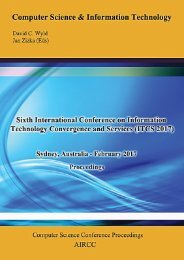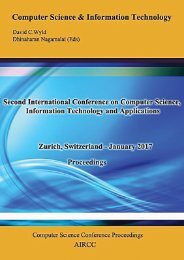CoSIT 2017
Fourth International Conference on Computer Science and Information Technology ( CoSIT 2017 ), Geneva, Switzerland - March 2017
Fourth International Conference on Computer Science and Information Technology ( CoSIT 2017 ), Geneva, Switzerland - March 2017
Create successful ePaper yourself
Turn your PDF publications into a flip-book with our unique Google optimized e-Paper software.
Computer Science & Information Technology (CS & IT) 157<br />
Notes: The table presents the regular expressions contained in the “Annual Report Algorithm” for deleting<br />
nonrelevant document (file) types.<br />
Next, the “Annual Report Algorithm” deletes all metadata included in the core document and the<br />
exhibits (RegExes 23-27). Table 6 illustrates the regular expressions for deleting metadata in SEC<br />
EDGAR documents.<br />
Table 6. Regular expressions contained in the “Annual Report Algorithm”<br />
Notes: The table presents the regular expressions contained in the “Annual Report Algorithm” for deleting<br />
nonrelevant document metadata.<br />
Before deleting all HTML elements and their corresponding attributes (RegEx 29) the algorithm<br />
deletes tables since they contain non-textual (quantitative) information (RegEx 28). Table 7 illustrates<br />
the set of regular expressions applied to delete tables and HTML elements embedded in financial<br />
statements filed with the SEC.<br />
Table 7. Regular expressions contained in the “Annual Report Algorithm”<br />
Notes: The table presents the regular expressions contained in the “Annual Report Algorithm” for deleting<br />
tables and HTML elements<br />
After extracting the core document and the exhibits as well as deleting all HTML elements, the<br />
“Annual Report Algorithm” adjusts the content embedded in the body section of each<br />
HTMLformatted document in order to extract textual elements from financial statements on the<br />
EDGAR database. According to the SEC filer manual the EDGAR system suspends financial<br />
statements which contain extended ASCII characters. However, it supports submissions with extended<br />
character references. By using ISO-8859-1/Latin-1 decimal character references or entity-names<br />
(either technique is allowed within SEC submissions) extended ASCII characters can be embedded in<br />
financial statement submissions. These extended character sets within HTML documents included in<br />
the “Complete Submission Text File” need to be decoded to be able to extract human-readable textual<br />
information from financial statements [34]. The “Annual Report Algorithm” finally decodes all<br />
extended character sets (RegExes 30-680) most likely embedded in financial statements filed with the<br />
SEC and its EDGAR system formatted in HTML 4.01 (ASCII, ANSI/Windows-1252, ISO-8859-<br />
1/Latin-1, mathematical, Greek, symbolic and special characters).<br />
5.3. Extraction Results<br />
By applying the “Annual Report Algorithm” investors and researchers are able to extract textual<br />
information from financial statements filed with the SEC for thousands of companies in a fully<br />
automated process. Based on the “Complete Submission Text File” provided by the EDGAR system<br />
the algorithm extracts the core (Form 10-K) document and the exhibits which have been embedded in<br />
the text version of a company´s financial statement. For example for Coca Cola´s 2015 annual report<br />
on Form 10-K filed on February 25, 2016 via EDGAR the algorithm extracts one core document in





